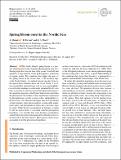Spring bloom onset in the Nordic Seas
Author(s)
Mignot, Alexandre; Ferrari, Raffaele; Mork, Kjell Arne
DownloadFerrari_Spring bloom.pdf (1.263Mb)
PUBLISHER_CC
Publisher with Creative Commons License
Creative Commons Attribution
Terms of use
Metadata
Show full item recordAbstract
The North Atlantic spring bloom is a massive annual growth event of marine phytoplankton, tiny free-floating algae that form the base of the ocean's food web and generates a large fraction of the global primary production of organic matter. The conditions that trigger the onset of the spring bloom in the Nordic Seas, at the northern edge of the North Atlantic, are studied using in situ data from six bio-optical floats released north of the Arctic Circle. It is often assumed that spring blooms start as soon as phytoplankton cells daily irradiance is sufficiently abundant that division rates exceed losses. The bio-optical float data instead suggest the tantalizing hypothesis that Nordic Seas blooms start when the photoperiod, the number of daily light hours experienced by phytoplankton, exceeds a critical value, independently of division rates. The photoperiod trigger may have developed at high latitudes where photosynthesis is impossible during polar nights and phytoplankton enters into a dormant stage in winter. While the first accumulation of biomass recorded by the bio-optical floats is consistent with the photoperiod hypothesis, it is possible that some biomass accumulation started before the critical photoperiod but at levels too low to be detected by the fluorometers. More precise observations are needed to test the photoperiod hypothesis.
Date issued
2016-06Department
Massachusetts Institute of Technology. Department of Earth, Atmospheric, and Planetary SciencesJournal
Biogeosciences
Publisher
Copernicus GmbH/European Geosciences Union
Citation
Mignot, Alexandre, Raffaele Ferrari, and Kjell Arne Mork. "Spring bloom onset in the Nordic Seas.” Biogeosciences 13.3485 (2016): 3485-3502.
Version: Final published version
ISSN
1726-4189